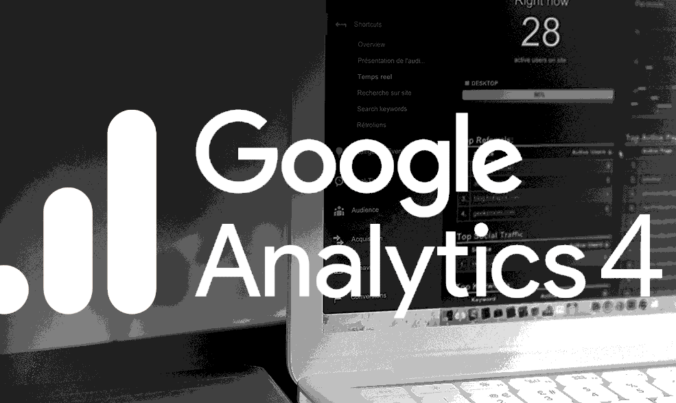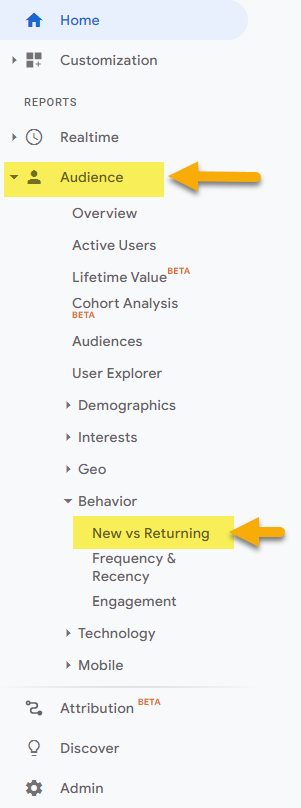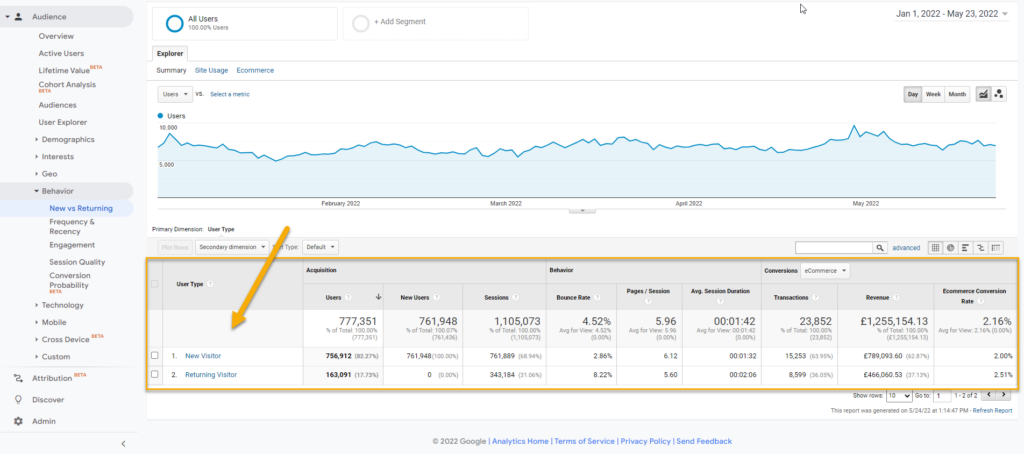- - Google Analytics - GA4 - Website Analytics - Google Analytics - GA4 - Website Analytics - Google Analytics - GA4 - Website Analytics


THE NEW VS RETURNING USERS METRIC IN GOOGLE ANALYTICS IS ONE OF THE FIRST METRICS YOU SEE WHEN OPENING THE PLATFORM. THIS FIGURE IS LOCATED AT THE TOP BECAUSE IT PROVIDES ONE OF THE BEST INDICATIONS OF HOW YOUR BUSINESS IS PERFORMING.
Understanding your new vs returning users ratio will help you fine tune the essentials of your success. When answering the above question, it is perhaps a good idea to start by defining each user.
New users are defined as having never visited your website or app before. They are logged at their first interaction, although will be logged as a returning user if they return within the tracking period.
Returning users have previously visited your website or app. They are more likely to spend time on your website and more likely to convert into a sale. Both users are incredibly important to a successful business. Understanding their behaviour is the key to maximising your potential.

It is important to be able to distinguish between your new and returning users as they each have their benefits.
New users are great for reports relating to your marketing strategies, your funnels and the function and usability of your website or app. A lot of first visit conversions is a strong indication that your strategies have been a success.
Monitoring these metrics and making amendments, then making further adjustments for positive/negative results can help you refine your conversion rate.
Returning users generally convert at a higher rate. A high returning user rate can indicate a product or service that is of good value. From your return rates, you can work out your customer retention rates and also your visit to purchase ratios.
These again, can be used to refine your processes, especially as rerunning customers are more likely to engage and spend time on your website or app. Looking at where they spend their time allows you to put your focus into funnelling those channels or pages through to a sale.

This becomes a difficult question to answer, as dependent on your business and products, the ratios will vary. What we do know is this, new customers are, on average, around 2-3% likely to convert. Returning customers are around 10-25% likely to convert.
What we also know, is that a new website gets around 80-90% of its traffic being new users, logically, right? So, if we take 100 users, of which 85 are new, and 15 are returning, using the median of the above percentages –
The temptation, therefore, is to focus on your retuning customer. Although what you are overlooking, is that the new business scales your operation. Without new business, growth is stagnant.
We’d argue that the golden ratio for new vs returning customers, is around 75% new, 25% returning.
With a solid 25% return rate, you are less reliant on Google and other channels for your traffic. This makes additional savings, but also maximises your conversion rate.
If your eCommerce site is hitting over 3% conversion rate, you’re on to a good thing. That figure is in the upper echelons of what is considered a good rate.

What is immediately apparent, is that new business is what feeds your growth. Although the conversion rate is much lower, bringing that new business back is where it blossoms. So working on customer retention, through email marketing, targeted ads such as<PPC and Social Media Ads, and SEO and ASO turns those new users into returning users, greatly increasing the chance of a conversion. Working out your own new vs returning users ratio might turn up slightly different results, although the logic should remain the same.
As we learnt, retuning users will spend more time on and engaging with your platforms. This is where you can really let your creativity shine. Create content that is engaging, focusses on your customers needs and funnels them through to other pages or converts.
This can help in other ways such as search rankings and can also bring in new users, as well as building confidence in your brand and products. Heatmaps are a great way to see where these interactions take place and where your sales funnel leaks occur. You can read more about sales funnels here.
You should try and nurture new and returning business with separate approaches. But also consider the bigger picture. Follow your customer journeys from new, to conversion and from return to conversion to see how efficient your efforts are across the whole spectrum.
If you’d like to talk in more detail about what we can do to set up your Google Analytics 4 for your business, we’d be happy to hear from you. Get in touch with us today!
Give us your email and we'll do the same thing every other performance marketing agency does... never email you.